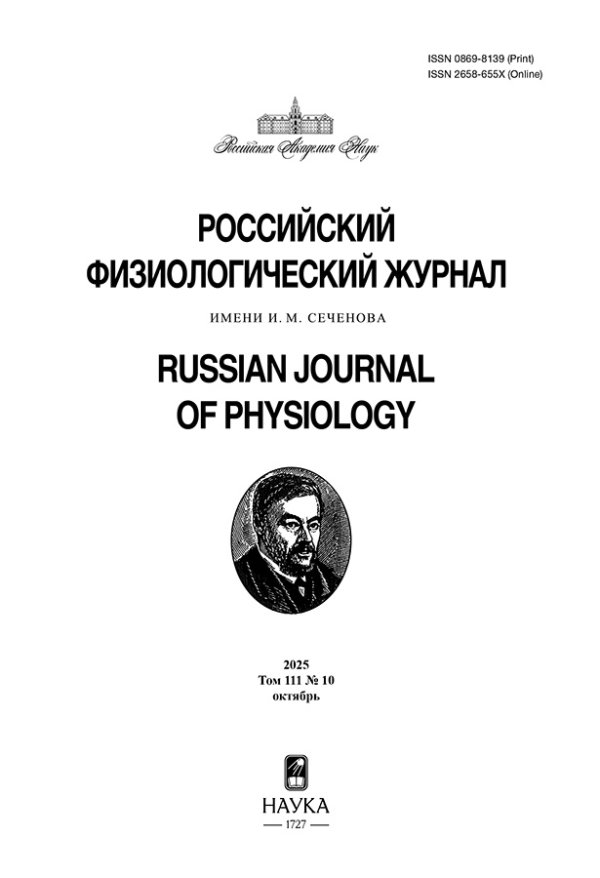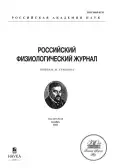Роль фосфолипазы С в модуляции электрической активности предсердных кардиомиоцитов развивающихся крыс при стимуляции α1-адренорецепторов
- Авторы: Мансур Н.1, Зефиров А.Л.2, Зиятдинова Н.И.1, Зефиров Т.Л.1
-
Учреждения:
- Казанский (Приволжский) федеральный университет
- Казанский государственный медицинский университет
- Выпуск: Том 110, № 12 (2024)
- Страницы: 1891-1901
- Раздел: ЭКСПЕРИМЕНТАЛЬНЫЕ СТАТЬИ
- URL: https://gynecology.orscience.ru/0869-8139/article/view/677900
- DOI: https://doi.org/10.31857/S0869813924120026
- EDN: https://elibrary.ru/VGEGPQ
- ID: 677900
Цитировать
Полный текст
Аннотация
Большинство существующих исследований сосредоточено на механизмах регуляции мембранного электрогенеза через β-адренорецепторы, в то время как электрофизиологические эффекты α1-адренорецепторов (α1-АР) остаются малоизученными. Участие фосфолипазы C (PLC) в этих эффектах остается неясным, и изучение неселективного агониста подтипов α1-АР метоксамина в присутствии ингибитора PLC (U-73122) может прояснить важность PLC в модуляции электрической активности кардиомиоцитов у крыс разных возрастов. Исследование проводилось на 7-, 21- и 100-дневных белых крысах с использованием микроэлектродной техники. Для анестезии использовали уретан, после чего проводили изоляцию сердца и готовили препарат миокарда предсердий с сохраненным синусовым узлом и спонтанной активностью. Затем регистрировали электрическую активность кардиомиоцитов. Применяли агонист α1-АР метоксамин и ингибитор PLC U-73122. Стимуляция α1-АР метоксамином в рабочих кардиомиоцитах правого предсердия крыс разного возраста приводила к увеличению частоты генерации потенциала действия. Метоксамин в концентрации 10–8 М увеличивал длительность потенциала действия у 7-дневных крыс, тогда как у 21- и 100-дневных крыс наблюдалось его уменьшение. U-73122 полностью блокировал действие метоксамина во всех возрастных группах, что указывает на важную роль PLC в этих процессах. Результаты показывают, что возраст влияет на реакцию кардиомиоцитов на стимуляцию α1-АР, а PLC является ключевым элементом в механизмах, обеспечивающих эти эффекты.
Ключевые слова
Полный текст
Об авторах
Н. Мансур
Казанский (Приволжский) федеральный университет
Автор, ответственный за переписку.
Email: nourm94@mail.ru
Россия, Казань
А. Л. Зефиров
Казанский государственный медицинский университет
Email: nourm94@mail.ru
Россия, Казань
Н. И. Зиятдинова
Казанский (Приволжский) федеральный университет
Email: nourm94@mail.ru
Россия, Казань
Т. Л. Зефиров
Казанский (Приволжский) федеральный университет
Email: nourm94@mail.ru
Россия, Казань
Список литературы
- Ahlquist RP (1948) A study of the adrenotropic receptors. Am J Physiol 153: 586–600. https://doi.org/10.1152/AJPLEGACY.1948.153.3.586
- Van Meel JC, de Jonge A, Timmermans PB, van Zwieten PA (1981) Selectivity of some alpha adrenoceptor agonists for peripheral alpha-1 and alpha-2 adrenoceptors in the normotensive rat. J Pharmacol Exp Therap 219: 760–767. https://jpet.aspetjournals.org/content/219/3/760.long
- McGrath JC (2015) Localization of α-adrenoceptors: JR Vane Medal Lecture. Br J Pharmacol 172: 1179–1194. https://doi.org/10.1111/BPH.13008/SUPPINFO
- Zhang J, Simpson PC, Jensen BC (2021) Cardiac a1A-adrenergic receptors: Emerging protective roles in cardiovascular diseases. Am J Physiol Heart Circ Physiol 320: H725–H733. https://doi.org/10.1152/ajpheart.00621.2020
- Akinaga J, García-Sáinz JA, Pupo SA (2019) Updates in the function and regulation of α1-adrenoceptors. Br J Pharmacol 176: 2343–2357. https://doi.org/10.1111/BPH.14617
- O’Connell TD, Jensen BC, Baker AJ, Simpson PC (2014) Cardiac Alpha1-Adrenergic Receptors: Novel Aspects of Expression, Signaling Mechanisms, Physiologic Function, and Clinical Importance. Pharmacol Rev 66: 308–333. https://doi.org/10.1124/PR.112.007203
- Kockskämper J, Zima A V., Roderick HL, Pieske B, Blatter LA, Bootman MD (2008) Emerging roles of inositol 1,4,5-trisphosphate signaling in cardiac myocytes. J Mol Cell Cardiol 45: 128–147. https://doi.org/10.1016/j.yjmcc.2008.05.014
- Lipp P, Laine M, Tovey SC, Burrell KM, Berridge MJ, Li W, Bootman MD (2000) Functional InsP3 receptors that may modulate excitation-contraction coupling in the heart. Current Biol 10: 939–942. https://doi.org/10.1016/S0960-9822(00)00624-2
- Domeier TL, Zima A V., Maxwell JT, Huke S, Mignery GA, Blatter LA (2008) IP3 receptor-dependent Ca2+ release modulates excitation-contraction coupling in rabbit ventricular myocytes. Am J Physiol Heart Circ Physiol 294: 596–604. https://doi.org/10.1152/ajpheart.01155.2007
- Harzheim D, Movassagh M, Foo RSY, Ritter O, Tashfeen A, Conway SJ, Bootman MD, Roderick HL (2009) Increased InsP3Rs in the junctional sarcoplasmic reticulum augment Ca 2+ transients and arrhythmias associated with cardiac hypertrophy. Proc Natl Acad Sci U S A 106: 11406–11411.https://doi.org/10.1073/PNAS.0905485106
- Ibarra C, Vicencio JM, Estrada M, Lin Y, Rocco P, Rebellato P, Munoz JP, Garcia-Prieto J, Quest AFG, Chiong M, Davidson SM, Bulatovic I, Grinnemo KH, Larsson O, Szabadkai G, Uhlén P, Jaimovich E, Lavandero S (2013) Local control of nuclear calcium signaling in cardiac myocytes by perinuclear microdomains of sarcolemmal insulin-like growth factor 1 receptors. Circ Res 112: 236–245. https://doi.org/10.1161/CIRCRESAHA.112.273839
- Gomez AM, Ruiz-Hurtado G, Benitah J-P, Dominguez-Rodriguez A (2013) Ca2+ Fluxes Involvement in Gene Expression During Cardiac Hypertrophy. Curr Vasc Pharmacol 11: 497–506. https://doi.org/10.2174/1570161111311040013
- Disatnik MH, Buraggi G, Mochly-Rosen D (1994) Localization of Protein Kinase C Isozymes in Cardiac Myocytes. Exp Cell Res 210: 287–297. https://doi.org/10.1006/EXCR.1994.1041
- Pucéat M, Hilal-Dandano R, Strulovicin B, Brunton LL, Brown JH (1994) Differential regulation of protein kinase C isoforms in isolated neonatal and adult rat cardiomyocytes. J Biol Chem 269: 16938–16944. https://doi.org/10.1016/S0021-9258(19)89480-2
- Steinberg SF (2012) Cardiac actions of protein kinase C isoforms. Physiology 27: 130–139. https://doi.org/10.1152/PHYSIOL.00009.2012
- Gada KD, Logothetis DE (2022) PKC regulation of ion channels: The involvement of PIP2. J Biol Chem 298: 102035. https://doi.org/10.1016/J.JBC.2022.102035
- MacMillan D, McCarron JG (2010) The phospholipase C inhibitor U-73122 inhibits Ca2+ release from the intracellular sarcoplasmic reticulum Ca2+ store by inhibiting Ca2+ pumps in smooth muscle. Br J Pharmacol 160: 1295–1301. https://doi.org/10.1111/J.1476-5381.2010.00771.X
- Zefirov TL, Khabibrakhmanov II, Ziyatdinova NI, Zefirov AL (2016) Peculiar Aspects in Influence of α1-Adrenoceptor Stimulation on Isolated Rat Heart. Bull Exp Biol Med 162: 4–6. https://doi.org/10.1007/S10517-016-3530-Z
- Khabibrakhmanov II, Kuptsova AM, Ziyatdinova NI, Mansur N, Zefirov TL (2020) Alpha(1)-Adrenoceptors Activation Decreases Myocardial Contractility in Newborn Rats. J Exp Biol Agricult Sci 322–326. https://doi.org/10.18006/2020.8(Spl-2-AABAS).S322.S326
- Mansour N, Ziyatdinova NI, Zefirov TL (2023) Methoxamine Plays a Role in the Regulation of the Electrical Activity of Newborn Rats. Opera Med Physiol 10: 59–64. https://doi.org/10.24412/2500-2295-2023-2-59-64
- Mansour N, Ziyatdinova NI, Gallieva AM, Shakirov RR, Zefirov TL (2023) Effect of α1 Adrenoreceptors Stimulation on Electrical Activity of Rat Atria. Biophysics (Russ Feder) 68: 607–611. https://doi.org/10.1134/S0006350923040115
- Robinson RB (1996) Autonomic receptor-effector coupling during post-natal development. Cardiovas Res 31: 68 –76.
- Ferron L, Capuano V, Deroubaix E, Coulombe A, Renaud JF (2002) Functional and molecular characterization of a T-type Ca2 + channel during fetal and postnatal rat heart development. J Mol Cell Cardiol 34: 533–546. https://doi.org/10.1006/jmcc.2002.1535
- Protas L, Barbuti A, Qu J, Rybin VO, Palmiter RD, Steinberg SF, Robinson RB (2003) Neuropeptide Y Is an Essential In Vivo Developmental Regulator of Cardiac ICa,L. Circ Res 93: 972–979. https://doi.org/10.1161/01.RES.0000099244.01926.56
- Li X, Zima A V., Sheikh F, Blatter LA, Chen J (2005) Endothelin-1-induced arrhythmogenic Ca2+ signaling is abolished in atrial myocytes of inositol-1,4,5-trisphosphate(IP3)-receptor type 2-deficient mice. Circ Res 96: 1274–1281. https://doi.org/10.1161/01.RES.0000172556.05576.4c
- Bare DJ, Kettlun CS, Liang M, Bers DM, Mignery GA (2005) Cardiac type 2 inositol 1,4,5-trisphosphate receptor: Interaction and modulation by calcium/calmodulin-dependent protein kinase II. J Biol Chem 280: 15912–15920. https://doi.org/10.1074/jbc.M414212200
Дополнительные файлы














